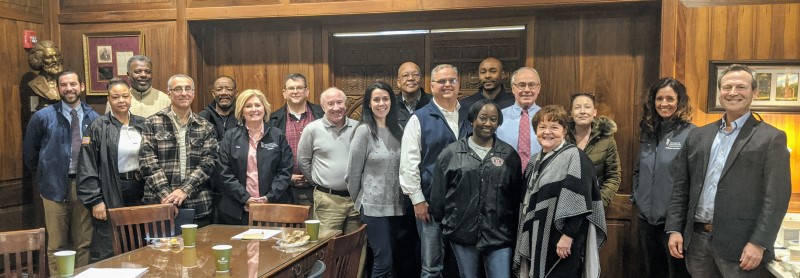News & Updates — Program Brief
Expanding Access to Opioid Use Disorder Treatment Before, During, and After Incarceration: Opportunities for Policy and Practice
November 23, 2020It’s estimated that 15 percent of individuals in the criminal justice system have opioid use disorder (OUD). As a group they face persistent gaps in treatment because many jails and prisons don’t provide medications for opioid use disorder (MOUD) nor support detainees in finding health insurance or treatment after their release. As a result, people leaving jails and prisons are at higher risk of overdose than the general population; one study found North Carolina inmates were 40 times more likely to die of an overdose within two weeks of release than other state residents.
Increasing access to OUD treatment for this vulnerable group was a high priority for FORE before the pandemic. It’s even more so now as changes in the operations of courts, jails, and prisons designed to prevent the spread of the coronavirus are limiting access to such treatment, as well as to drug diversion and recovery programs. But FORE grantees have found creative ways of surmounting the obstacles COVID-19 has put in their path.

Telemedicine as Pathway to Continuous Treatment
At the University of Maryland, Baltimore, addiction medicine faculty are working with four county jails on the Eastern Shore to establish MOUD programs. They are providing guidance on COVID-19-safe policies and procedures in rural facilities, as well as technology that enables detainees to have telemedicine consults with university providers and establish relationships that offer a pathway to continued MOUD treatment upon release. Despite the barriers imposed by the pandemic, one of the jails has already begun providing MOUD to detainees. “COVID-19 forced us to get creative and adapt our originally planned approach,” says Eric Weintraub, M.D., principal investigator and associate professor of psychiatry at the University of Maryland School of Medicine. “We took advantage of emergency regulations around telehealth and quickly installed a laptop with video conferencing to care for patients while we await COVID-19 restrictions on visitors to the jail being lifted.” This approach, should it prove effective, could become a model for other Maryland correctional facilities, which are required under a new state law to provide access to MOUD by January 2023.
Best Practices for MOUD in Correctional Settings
To provide further operational guidance to correctional facilities across the U.S., we asked Lauren Brinkley-Rubinstein, Ph.D., and Nickolas D. Zaller, Ph.D., two researchers who study the impacts of the criminal justice system on addiction, mental health, and other health outcomes, to highlight best practices for safely providing MOUD in jails and prisons during the pandemic. Their article, “MOUD Provision in Correctional Settings During Time of COVID-19: Prevention and Solutions,” was published in the December issue of the Journal of Addiction Medicine. Their recommendations include delivering medications cell-side, delivering virtual peer support and educational programming, and developing re-entry protocols to ensure people have access to MOUD and social supports after their release, which is even more important during a crisis.
On-Demand Supports to Engage People in Drug Courts, Diversion Programs
Providing supports to people before they enter jails and prisons is also critical. The Addiction Policy Forum has partnered with drug courts and drug diversion programs in states such as Arkansas, Illinois, and North Carolina to provide free access to its Connections mobile app, which offers on-demand treatment and supports from addiction specialists and peers. The app, which was developed in partnership with the National Institute of Drug Abuse and the Network for Improvement of Addiction Treatment, supports patients through all phases of their recovery. It trains users in critical recovery skills through digital cognitive behavioral therapy techniques and offers a dedicated support group for patients following buprenorphine regimens.
Funding from FORE will enable the Addiction Policy Forum to expand the features of the app to engage justice-involved individuals in new ways, using discussion groups, medication and appointment reminders, daily check-ins, brief surveys, videos, interactive exercises, and quizzes. The Addiction Policy Forum has already received requests for 6,000 individuals for 1,000 available subscriptions — an indication of the high degree of unmet need among people in the criminal justice system with OUD.
Scaling Promising Approaches Through Policy Change
Part of the way we hope to meet that need is by sharing promising approaches with policymakers far and wide. The Legal Action Center, which uses legal and policy strategies to promote health equity and reduce discrimination against people with criminal records, substance use disorders, and/or HIV/AIDS, is helping us by collecting information on model programs and opportunities to improve access to MOUD throughout the correctional system. Part of this work involves educating policymakers about unrealized opportunities to leverage Medicaid policy, benefits, and regulations to ensure continuous health care coverage and increase diversion from the correctional system to community-based OUD treatment and supports.
“When people addicted to opioids come into contact with the justice system, we have an opportunity to offer and engage them in evidence-based treatment,” says Ken Shatzkes, Ph.D., senior program officer of FORE. “Our grantees are finding creative ways to do this during the pandemic — ones that may point the way toward longer-term, sustainable solutions.”